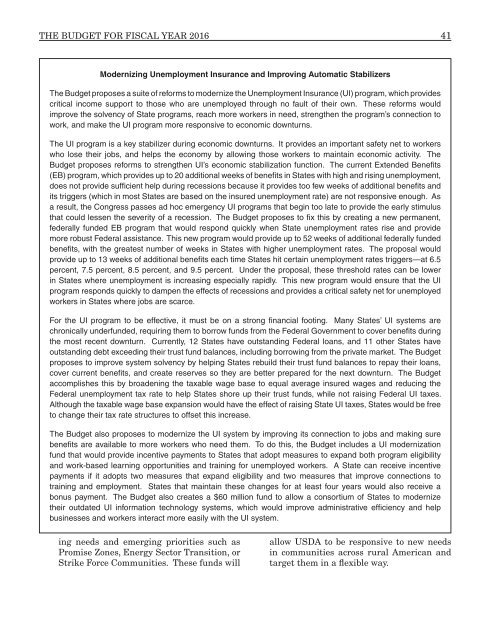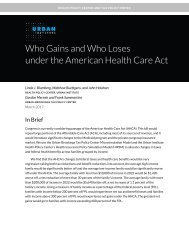BUDGET-2016-BUD
BUDGET-2016-BUD
BUDGET-2016-BUD
Create successful ePaper yourself
Turn your PDF publications into a flip-book with our unique Google optimized e-Paper software.
THE <strong><strong>BUD</strong>GET</strong> FOR FISCAL YEAR <strong>2016</strong> 41<br />
Modernizing Unemployment Insurance and Improving Automatic Stabilizers<br />
The Budget proposes a suite of reforms to modernize the Unemployment Insurance (UI) program, which provides<br />
critical income support to those who are unemployed through no fault of their own. These reforms would<br />
improve the solvency of State programs, reach more workers in need, strengthen the program’s connection to<br />
work, and make the UI program more responsive to economic downturns.<br />
The UI program is a key stabilizer during economic downturns. It provides an important safety net to workers<br />
who lose their jobs, and helps the economy by allowing those workers to maintain economic activity. The<br />
Budget proposes reforms to strengthen UI’s economic stabilization function. The current Extended Benefits<br />
(EB) program, which provides up to 20 additional weeks of benefits in States with high and rising unemployment,<br />
does not provide sufficient help during recessions because it provides too few weeks of additional benefits and<br />
its triggers (which in most States are based on the insured unemployment rate) are not responsive enough. As<br />
a result, the Congress passes ad hoc emergency UI programs that begin too late to provide the early stimulus<br />
that could lessen the severity of a recession. The Budget proposes to fix this by creating a new permanent,<br />
federally funded EB program that would respond quickly when State unemployment rates rise and provide<br />
more robust Federal assistance. This new program would provide up to 52 weeks of additional federally funded<br />
benefits, with the greatest number of weeks in States with higher unemployment rates. The proposal would<br />
provide up to 13 weeks of additional benefits each time States hit certain unemployment rates triggers—at 6.5<br />
percent, 7.5 percent, 8.5 percent, and 9.5 percent. Under the proposal, these threshold rates can be lower<br />
in States where unemployment is increasing especially rapidly. This new program would ensure that the UI<br />
program responds quickly to dampen the effects of recessions and provides a critical safety net for unemployed<br />
workers in States where jobs are scarce.<br />
For the UI program to be effective, it must be on a strong financial footing. Many States’ UI systems are<br />
chronically underfunded, requiring them to borrow funds from the Federal Government to cover benefits during<br />
the most recent downturn. Currently, 12 States have outstanding Federal loans, and 11 other States have<br />
outstanding debt exceeding their trust fund balances, including borrowing from the private market. The Budget<br />
proposes to improve system solvency by helping States rebuild their trust fund balances to repay their loans,<br />
cover current benefits, and create reserves so they are better prepared for the next downturn. The Budget<br />
accomplishes this by broadening the taxable wage base to equal average insured wages and reducing the<br />
Federal unemployment tax rate to help States shore up their trust funds, while not raising Federal UI taxes.<br />
Although the taxable wage base expansion would have the effect of raising State UI taxes, States would be free<br />
to change their tax rate structures to offset this increase.<br />
The Budget also proposes to modernize the UI system by improving its connection to jobs and making sure<br />
benefits are available to more workers who need them. To do this, the Budget includes a UI modernization<br />
fund that would provide incentive payments to States that adopt measures to expand both program eligibility<br />
and work-based learning opportunities and training for unemployed workers. A State can receive incentive<br />
payments if it adopts two measures that expand eligibility and two measures that improve connections to<br />
training and employment. States that maintain these changes for at least four years would also receive a<br />
bonus payment. The Budget also creates a $60 million fund to allow a consortium of States to modernize<br />
their outdated UI information technology systems, which would improve administrative efficiency and help<br />
businesses and workers interact more easily with the UI system.<br />
ing needs and emerging priorities such as<br />
Promise Zones, Energy Sector Transition, or<br />
Strike Force Communities. These funds will<br />
allow USDA to be responsive to new needs<br />
in communities across rural American and<br />
target them in a flexible way.



